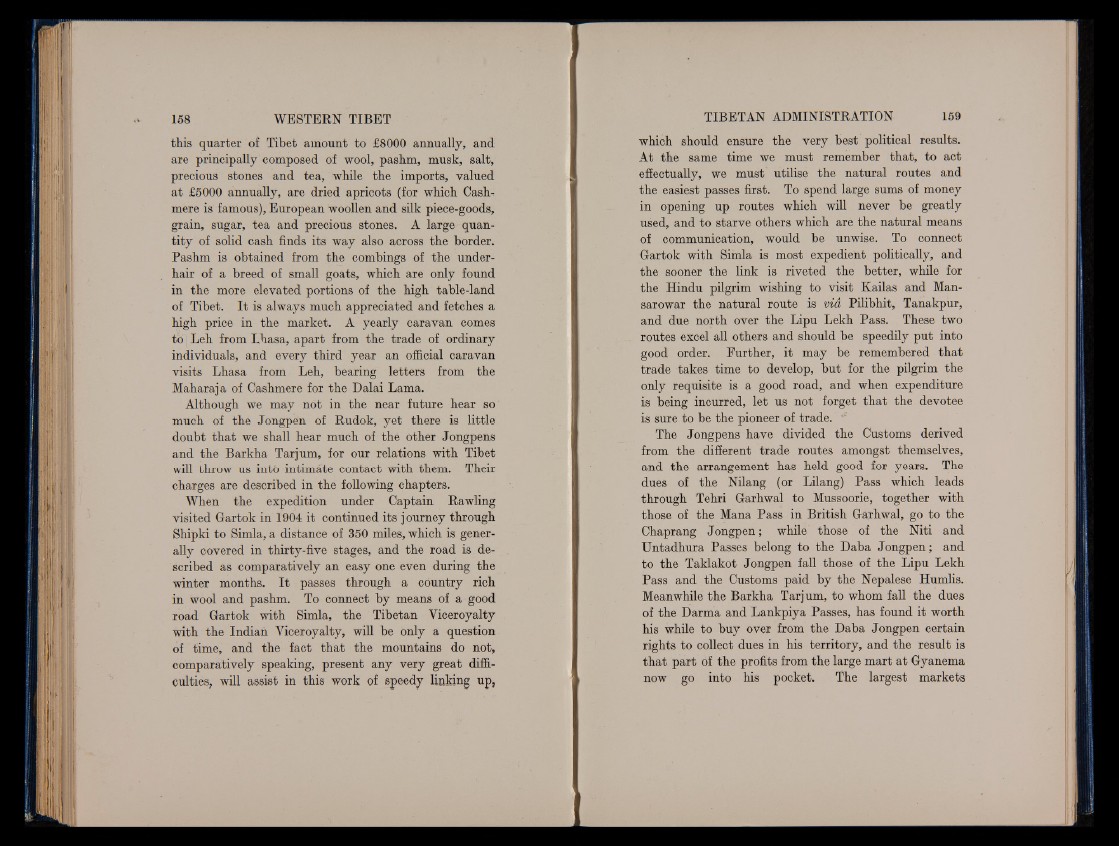
this quarter of Tibet amount to £8000 annually, and
are principally composed of wool, pashm, musk, salt,
precious stones and tea, while the imports, valued
at £5000 annually, are dried apricots (for which Cash-
mere is famous), European woollen and silk piece-goods,
grain, sugar, tea and precious stones. A large quantity
of solid cash finds its way also across the border.
Pashm is obtained from the combings of the underhair
of a breed of small goats, which are only found
in the more elevated portions of the high table-land
of Tibet. I t is always much appreciated and fetches a
high price in the market. A yearly caravan comes
to Leh from Lhasa, apart from the trade of ordinary
individuals, and every third year an official caravan
visits Lhasa from Leh, bearing letters from the
Maharaja of Cashmere for the Dalai Lama.
Although we may not in the near future hear so
much of the Jongpen of Rudok, yet there is little
doubt that we shall hear much of the other Jongpens
and the Barkha Tarjum, for our relations with Tibet
will throw us into intimate contact with them. Their
charges are described in the following chapters.
When the expedition under Captain Rawling
visited Gartok in 1904 it continued its journey through
Shipki to Simla, a distance of 350 miles, which is generally
covered in thirty-five stages, and the road is described
as comparatively an easy one even during the
winter months. I t passes through a country rich
in wool and pashm. To connect by means of a good
road Gartok with Simla, the Tibetan Yiceroyalty
with the Indian Yiceroyalty, will be only a question
of time, and the fact that the mountains do not,
comparatively speaking, present any very great difficulties,
will assist in this work of speedy linking up,
which should ensure the very best political results.
At the same time we must remember that, to act
effectually, we must utilise the natural routes and
the easiest passes first. To spend large sums of money
in opening up routes which will never be greatly
used, and to starve others which are the natural means
of communication, would be unwise. To connect
Gartok with Simla is most expedient politically, and
the sooner the link is riveted the better, while for
the Hindu pilgrim wishing to visit Kailas and Man-
sarowar the natural route is via Pilibhit, Tanakpur,
and due north over the Lipu Lekh Pass. These two
routes excel all others and should be speedily put into
good order. Further, it may be remembered that
trade takes time to develop, but for the pilgrim the
only requisite is a good road, and when expenditure
is being incurred, let us not forget that the devotee
is sure to be the pioneer of trade. '
The Jongpens have divided the Customs derived
from the different trade routes amongst themselves,
and the arrangement has held good for years. The
dues of the Nilang (or Lilang) Pass which leads
through Tehri Garhwal to Mussoorie, together with
those of the Mana Pass in British Garhwal, go to the
Chaprang Jongpen; while those of the Niti and
Untadhura Passes belong to the Daba Jongpen; and
to the Taklakot Jongpen fall those of the Lipu Lekh
Pass and the Customs paid by the Nepalese Humlis.
Meanwhile the Barkha Tarjum, to whom fall the dues
of the Darma and Lankpiya Passes, has found it worth
his while to buy over from the Daba Jongpen certain
rights to collect dues in his territory, and the result is
that part of the profits from the large mart at Gyanema
now go into his pocket. The largest markets